Research Article
INFLUENCE FACTORS OF CONSUMPTION WILLINGNESS FOR E-SPORTS PRODUCTS A CASE STUDY OF
12082
Views & Citations11082
Likes & Shares
E-sports products are a new form of sports tourism development. With the development of information technology and industry penetration, e-sports industry has entered a rapid expansion stage. A variety of new products with entertainment and ornamental value continue to emerge, driving e-sports consumption growth. Based on the study of consumption willingness, this paper studies the factors affecting the consumption willingness of e-sports products. The research results indicate that the intrinsic characteristics of the products can have a significant positive impact on consumers’ consumption experience and consumption willingness.
Keywords: E-sports Game Player Consumption Willingness Influence Factors.
Sports tourism is a new industry form that deeply integrates tourism industry and sports industry. As a product of industrial integration and development, sports tourism is of great significance to the transformation and upgrading of tourism industry and sports industry. The document entitled "Statistical Classification of Sports Industry'', which was issued by the National Bureau of Statistics in 2019, classifies e-sports as a performance activity in professional sports competitions. The coding of e-sports is of the same type as football, basketball, volleyball, table tennis, badminton, marathon, boxing, and Go.
1E-sports was especially popular in the year of 2019. The number of e-sports users in China exceeded 350million, and the industrial ecological scale reached
¥13.8billion yuan. 2According to the 2020 Global Esports Market Report data, China accounted for the largest share of the revenues, generating 35.0% of the global total. The number of e-sports viewers accounted for 32.93% of the total number of global e-sports viewers, both ranking first globally. 3According to the data calculation of iResearch, the market size of China's e-sports reached
¥140.6billion yuan in 2020, shooting up by 20% from a year earlier.4
In 2019, the total ticket revenue of 885 major e-sports events worldwide was $56.4million. In 2020, consumers' total consumption of e-sports tickets and peripheral products reached $122million.5 Consumers play an important role in generating economic benefits in the e-sports industry. But in contradiction to the fast-growing e-sports consumer market, there is little research on the willingness to consume e-sports products. The research on the consumption intention of e-sports products will help the relevant operators better manage different consumer groups, capture consumer psychology, meet consumer needs, avoid related risks in product research and development, and provide a new direction for the feature development of e-sports products in the future. Therefore, it is necessary to study the factors that affect the willingness to consume e-sports products.
"King of Glory" is a domestic MOBA (Multiplayer Online Battle Arena) mobile game released by Tencent TiMi Studio Group in 2015. "King of Glory" currently has more than 200million registered users, and its peak number of people who used the service at least once a day exceeds 100million6, making it a national mobile game. In 2016, KPL was held for the first time. The total peak number of viewers of the KPL Autumn Games in 2020 was nearly 110million, making KPL a representative event of mobile e-sports. Taking "King of Glory" game player as an example, this article explores the factors affecting the willingness to consume e- sports products, analyzes the relationship between the influencing factors and consumer willingness and proposes suggestions for product developers, market operators, and consumers to promote the sound development of e-sports industry in China.
RELATED RESEARCH ON E-SPORTS
RELATED RESEARCH ON E-SPORTS
Domestic Research
Due to the relatively late emergence of the e-sports industry, most domestic studies are after 2000. Regarding the definition of e-sports, (Li ,2004). believes that e-sports is a sports activity in which people or teams use computer facilities to conduct competitions in accordance with unified competition rules through a virtual platform created by the network. E-sports mainly includes three essential elements: electronic, competitive sports, and competition. He (2004) believes that e-sports are sports and can be divided into three types: sports with realistic prototypes that do not rely on figurative virtualization, such as online chess and cards, etc.; sports that have realistic prototypes but rely on figurative virtualization, such as racing games; sports without actual prototypes that rely on figurative virtualization, such as FPS (First-Person Shooting Game), RTS (Real-Time Strategy Game), etc. (Ma & Cui, 2009) Believe that e-sports is the highest form of online game development. Online games are a form of e-sports. E-sports is an antagonistic electronic game movement between people or between people and computers in the virtual environment created by information technology and under sports rules.
Regarding the development of the e-sports industry, (Yang et al. 2014). Notes that we should extend the e-sports industry to related industries and establish a diversified profit model. At the same time, attention should be paid to the role of capital, technology, and talents in the growth of e-sports industry. According to ( Li & Huang, 2016) the development of China's e-sports industry is facing such problems as single capital accumulation mode, lack of professional management talents, imperfect club operation, professional player cultivation, and lagging brand building. (Wang, 2018). points out that the domestic e-sports industry's development trend is specialization, marketization, mobilization, entertainment, and virtualization. (Yang, 2018). states that 2017 to present is a stage when all kinds of e-sports (arcade, PC, mobile) prospered together. In the future, new ports and new technologies will become the most critical factors influencing the next generation of e-sports.
Foreign Research
With regard to the definition of e-sports, (L loners ,2017). agrees that e- sports games are an actual sporting activity and explores some reasons. According to (Hamari & Sjoblom, 2017) e-sports is a form of sport facilitated by electronic systems. The human-machine interface mediates the input of players and teams and the output of e-sports systems. E-sports refer to competitive video games.
In terms of the e-sports industry, (Funk et al. 2018) advocate incorporating organized e-sports activities and competitions into sports management, while e- sports must meet specific sports definition standards. As a sports entertainment product, e-sports is a huge development opportunity for sports and related organizations. Research believes that sports management scholars should make full use of the potential of e-sports and provide guidance for the industry through education and research. Research by (Pizzo, et al. 2018). shows that e-sports and
traditional sports have similar consumption patterns, indicating that sports industry professionals can manage and market e-sports events in the same way as traditional sports. (Cunningham, et al. 2018). believe that e-sports are related to many achievements, including physical and mental health, social well-being, sports consumption results, as well as diversity and inclusion.
Compared with domestic research, foreign research is more mature because it focuses on not only the concept of e-sports and industrial development issues but also the social benefits of the e-sports industry.
RESEARCH OBJECT AND DESIGN
This article takes players of the mobile e-sports game "King of Glory", and the consumers who participated in the e-sports activities related to the "King of Glory," such as watching live games and offline events as the research object. In recent years, "King of Glory" with a vast of users has successfully hosted many large-scale professional competitions. The major e-sports clubs operate well and the industrial chain is becoming increasingly mature. The "King of Glory" game studied in this article belongs to the mobile e-sports within the category of e-sports games. Mobile sports have high research and practical value due to their vast market size and development potential though they emerged later than traditional sports.
According to research needs, a questionnaire about the consumption willingness of e-sports products was compiled. The whole survey was divided into pre-survey and formal survey. The collected pre-survey samples were tested by independent t test, Cronbach's index analysis, correlation analysis and etc. to obtain the standard questionnaire after correction. Distribution forms including sending questionnaire to the player group of “King of Glory” online and issuing questionnaire at KPL finals and e-sports club activities in some universities offline. Through processing and analyzing the questionnaire data, the test of the model and hypothesis were completed. First, descriptive statistical analysis and reliability and validity analysis were conducted using SPSS. Secondly, AMOS was used to further test and revise the model to verify the rationality of hypotheses. Finally, conclusions were drawn and corresponding opinions were put forward based on data analysis results.
RESEARCH HYPOTHESES AND ANALYSIS
Research Hypotheses
Regarding the relationship between consumption experience and consumption willingness. Liao (2005) points out that there is no unified concept of consumption experience. Still, scholars at home and abroad reach the consensus that consumption experience is the psychological feeling generated by consumers during the consumption process. This study refers to the relevant feelings and cognitions obtained during the consumption of e-sports products. Zhang (2005) proposes that consumption experience has five dimensions: sensory experience,
emotional experience, achievement experience, mental experience, and spiritual experience. Spiritual experience refers to the experience generated in pursuing a spiritual destination, such as religious experience. Since it is difficult for consumption experience of e-sports products to reach this depth, this article focuses on the four dimensions of consumption experience: sensory experience, emotional experience, achievement experience, and mental experience.
H1: Consumption experience has a positive impact on the consumption willingness of e-sports product consumers.
Regarding the relationship between product characteristics, consumption experience and consumption willingness. Product characteristics are a series of elements that reflect the uniqueness of a particular product. For e-sports products, product characteristics refer to the traits that can attract consumers in addition to essential functions. The research of (Li, 2010) shows that product attributes positively impact consumption experience and consumption willingness of mobile game users. Compared with product attributes, product characteristics can better reflect the difference of products. Therefore, this study believes that product characteristics can positively impact consumption experience and willingness.
H2: Product characteristics have a positive impact on the consumption experience of e-sports product consumers.
H3: Product characteristics have a positive impact on the consumption willingness of e-sports product consumers.
Regarding the relationship between incentive factors, consumption experience and consumption willingness. Incentive factors are the concept of organizational behavior, which refer to those factors that can bring positive attitudes, satisfaction and motivation. Research objects mainly focus on corporate employees. This research focuses on the primary role of incentive factors, extending incentive factors as the marketing methods adopted by the suppliers of e-sports products to encourage consumers to consume e-sports products. Zhao (2017) shows that intelligent marketing can bring consumers a better consumption experience. Xiang (2018) finds that Weibo marketing factors positively influence consumption intentions through perceived value and trust. Therefore, this study believes that through specific incentives, e-sports product suppliers can not only improve consumers' consumption experience, but also enhance consumers' willingness to consume.
H4: Incentive factors have a positive impact on the consumption willingness of e- sports product consumers.
H5: Incentive factors have a positive impact on the consumption experience of e- sports product consumers.
Regarding the relationship between external environment and the consumption willingness. External environment refers to external factors that have nothing to do with the product's attributes. Wang (2016) indicates that the external environment of e-sports is divided into "hard" environment and "soft" environment. "Hard"environment refers to the requirements of e-sports on electronic equipment and networks, and "soft" environment refers to opinions of public, relatives and friends on e-sports. External environment in this study refers to the surrounding environment that affects consumers’ psychology and behavior, including social environment (public opinion), reference groups, consumption locations, time pressure and other factors. (Liu & Liu, 2017) points out that positive (or negative) online public opinions have a significant positive (or negative) impact on consumers' purchase intentions. Based on this, this study believes that external environment has a positive impact on consumers' willingness to consume e-sports products.
H6: External environment has a positive impact on the consumption willingness of e-sports product consumers.
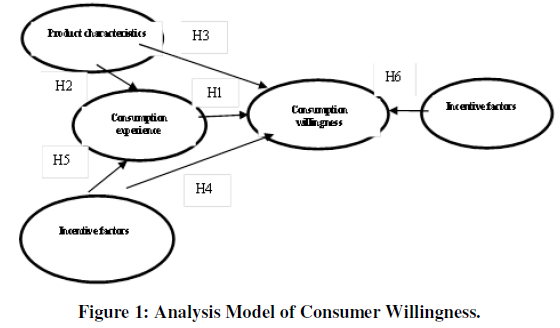

Based on above assumptions, this research constructs a conceptual model between product characteristics, incentive factors, external environment, consumption experience, and consumption willingness, as shown in (Figure 1).
RESEARCH ANALYSIS AND RESULTS
This article combined online and offline methods to conduct a questionnaire survey. The online channel was the “King of Glory” game group, and the offline channel was mainly the scene of the “King of Glory” game, which to a large extent ensured that the subjects of the survey were the “King of Glory” players, thereby improving the effectiveness of data collection. In the end, 310 questionnaires were distributed and 284 valid questionnaires were returned.
In order to understand the basic distribution of the interviewed group, this study conducted a descriptive statistical analysis of the collected samples, including demographic characteristics and characteristics of the interviewed group.
From the results of demographic characteristics, the difference in the proportion of male and female players among the surveyed groups is not obvious, indicating that there is no significant gender difference in the acceptance of the
“King of Glory”. The 18-30 years old group accounts for the largest proportion. At present, the student group still constitutes the mainstream participant group of e- sports games, accounting for 56.3% of the total; followed by personnel from enterprises and institutions, accounting for 14.7% of the total. By summarizing the characteristics of the group, the common point is that the group is relatively young, has strong cognitive and learning abilities, and has a strong ability to accept new things.
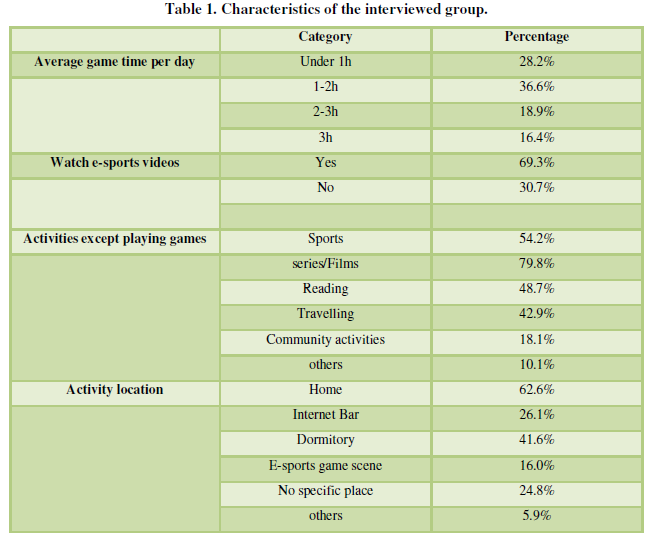

It can be seen in Table 1 that most of the game players of “King of Glory” spend 1-2 hours a day on the game. At the same time, players will choose to watch e-sports related videos. These activities are mostly at home or dormitory. In addition to games, e-sports players have other hobbies. Nearly 79.8% of the informants will choose to watch series or films in their free time, and some will also choose to read or travel, indicating that playing games is just a part of daily leisure for most respondents.
According to the research hypothesis of this article, five latent variables are set as consumption experience, external environment, product characteristics, incentive factors, and willingness to consume with totally 31 observation variables. Using SPSS to analyze the returned data, the results are in (Table 2). The mean values are all above 3, and the questionnaire items can roughly reflect their willingness to consume. At the same time, the skewness is in the range of -1 to 1, the kurtosis is in the range of -3 to 3, and the skewness and kurtosis are both within a reasonable range, which satisfies the normal distribution assumption.
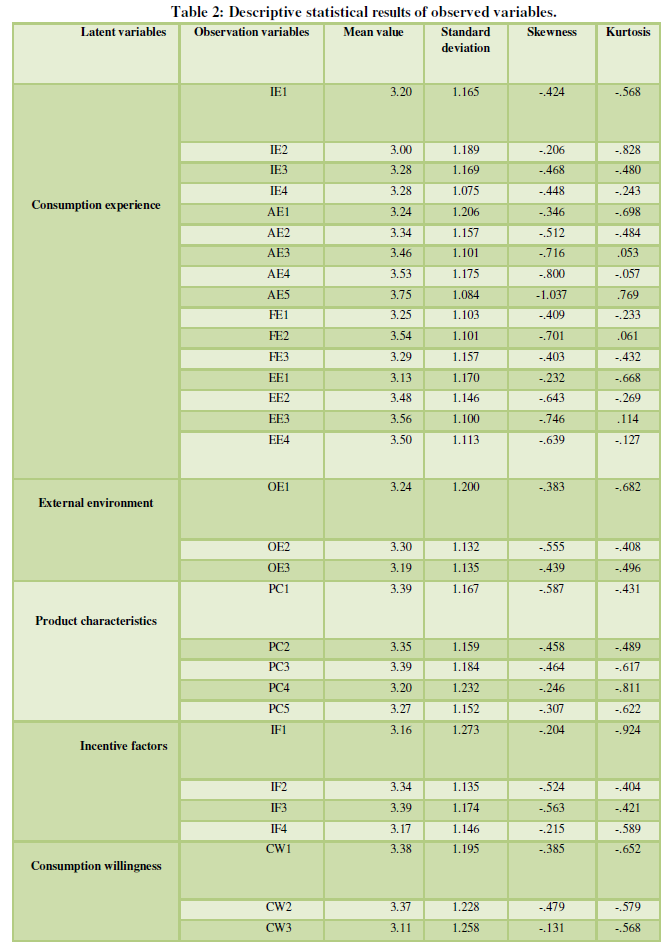

KMO measurement and Cronbach index measurement were performed on the questionnaire samples. The results are shown in (Table 3). The Cronbach’s Alpha values of the research data are all above 0.8, indicating that the questionnaire items have good consistency, and the KMO values are all above 0.7, which means good structure validity and meets the requirements of factor analysis. AVE’s square root of each index indicates that the overall dimension of the model has discriminative validity.
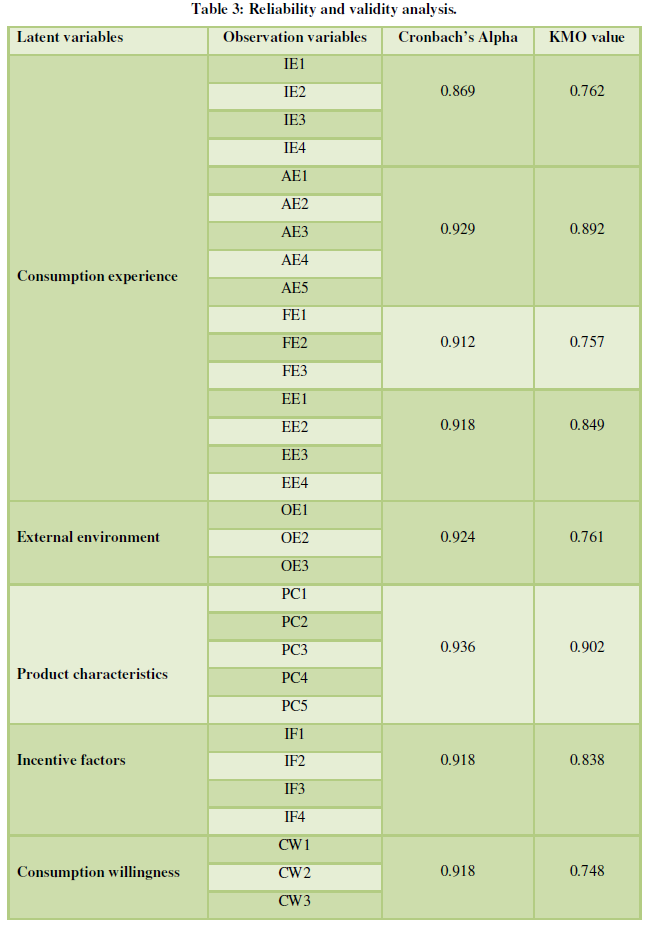
Next, this research uses AMOS24.0 to further test the relationship between consumer experience, consumer willingness, product characteristics, external environment, and motivational factors, find the fitting index, and obtain the path coefficient with the maximum likelihood estimation method. Calculating fitting index, the initial fitting results are shown in (Table 4).


The fitting results show that the significance of the external environment to consumption willingness and consumption experience to consumption willingness fails to meet the standard, but the correction index (M1) gives a certain room for improvement. According to the modified index, the covariant relationship is added between the residual items, and the modified model is finally obtained. The fitting index of the modified model reaches the standard level.
The coefficient estimation results of the model are shown in (Table 5). P value shows the significance of the influence relationship of each path, and P value less than 0.05 means that the influence relationship of the path is established. It can be seen from the table that the four influence paths of incentive factors - consumption willingness, incentive factors - consumption experience, external environment - consumption willingness, and consumption experience-consumption willingness are not significant, so we reject H1, H4, H5 and H6.
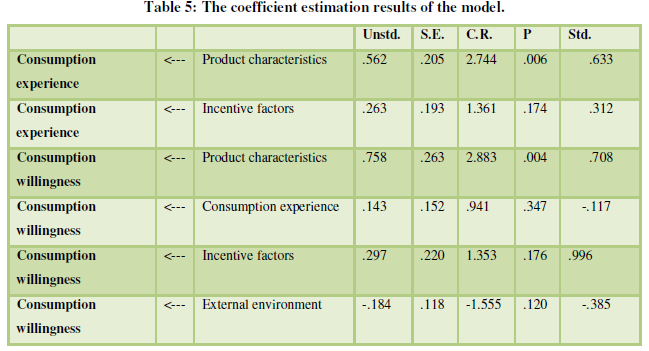

The reason for rejecting H1 can be explained as that good consumption experience may not immediately provoke players' willingness to consume which will only be generated under the combined effect of their own economic conditions and other external environments. As a marketing tool, incentive factors have an impact on consumption willingness only under the synergistic effect of the product itself, making H4 and H5 insignificant. Due to the development and change of the
concept of social life, people are increasingly showing independent self-awareness and decision-making, which will weaken the external environmental impact of consumption choices to a certain extent, resulting in H1 insignificant. At the same time, the standardized regression coefficient of product characteristics on consumption experience is 0.633, and the standardized regression coefficient of product characteristics on consumption willingness is 0.708. Both are above 0, and the significance is up to the standard. Therefore, H2 and H3 are accepted.
CONCLUSIONS AND IMPLICATIONS
The research results indicate that e-sports products' characteristics have a significant positive impact on consumption experience of e-sports products. In the field of sports, game products obviously have life cycle characteristics. To extend the life cycle of e-sports games, it is essential to continually improve players’ experience, which needs relevant personnel to first pay attention to the characteristics of the product itself. Product characteristics also have a significant positive impact on consumption willingness of e-sports products. The first thing consumers pay attention to when purchasing products and services is the intrinsic properties. Both virtual products in games and derivative products of e-sports, such as e-sports events and peripheral products, should be developed starting with the quality and design of the products, including the fun and beauty of the game products, the artistic and creative nature of the peripheral products, and the appreciation of the event products. Product characteristics are an essential consideration in determining product consumption.
“King of Glory” is currently in a relatively hot state of market consumption, and it is still necessary to extend its mature development period. First of all, continuing to develop and update the details of the product is required and the development direction of product updates can be captured by investigating actual preferences of game players.
Second, it is suggested that analyzing and learning from the development experience of other game competitors. For example, LOL and DOTA hosted international events, which has dramatically increased consumer enthusiasm for e- sports games. Almost every international game can trigger a new round of confidence. At the same time, they also seized the industrial opportunity of incorporating e-sports products into 2022 Hangzhou Asian Games, which has promoted the renewal and development of the products themselves, and create a development path for international competitions. Finally, developers need to use marketing methods to stimulate consumption and increase experience such as celebrity endorsements, cultural and creative figures, etc. The economic value of e- sports products includes game products themselves and peripheral products and event products. From the perspective of game products, players consume virtual products, while peripheral products designed around virtual game products are physical. For example, limited products, commemorative products, and blind box creatives are effective means to activate virtual products.
This article made a preliminary study on the factors affecting the consumption intention of e-sports products. Subsequent investigation should expand research samples and consider consumers' economic status, values, cognitive status, and other influencing factors to further deepen and improve research results.
1 The National Bureau of Statistics. Classification of Sports Industry Statistics (2019) [R]. Official Website of the National Bureau of Statistics http://www.stats.gov.cn/.
2 Improving quality and efficiency of Service industry development [R]. Official Website of the National Bureau of Statistics http://www.stats.gov.cn/.
3 2020 Global E-sports Market Report [R]. Official Website of Newzoo https://newzoo.com.
4 China's e-sports industry is developing rapidly, with an output value of 140 billion yuan in 2020 [N]. Reference News, 2021.1.18.
5 2020 Global E-sports Market Report [R]. Official Website of Newzoo https://newzoo.com.
- Cunningham, G.B., Fairley, S., Ferkins, L. (2018). eSport: Construct specifications and implications for sport management. Sport Management Review 21(1), 1-6.
- Funk, D.C., Pizzo, A.D., & Baker, B.J. (2018). Esport management: Embracing esport education and research opportunities. Sport Management Review 21(1), 7-13.
- Hamari, J., & Sjoblom, M. (2017). What is esports and why do people watch it Internet Research 14(9), 5898-5909.
- Karhulahti, V.M. (2017). Reconsidering Esport Economics and Executive Ownership. Physical Culture and Sport Studies and Research 74(1), 43-53.
- Llorens, M.R. (2017). eSport Gaming The Rise of a New Sports Practice. Sport Ethics and Philosophy 11(4), 464-476.
- Pizzo, A.D., Baker, B.J., Na, S. (2018). eSport vs. Sport A Comparison of Spectator Motives. Sport Marketing Quarterly 27(2), 108-123.
- He, W. (2004). Analysis of related concepts and types of esports. Sports Culture Guide 5, 11-13. Liao, Y.C. (2005). Literature review of consumption experience and its management. Economic
- Management (14), 43-50.
- Li, L.L. (2010). Research on factors affecting consumption intention of mobile games Masters degree paper. Dalian: Dongbei University of Finance and Economics.
- Liu, Y.H., Liu, Y.S. (2017). Research on the influence of online public opinion on consumers purchase intention Based on the moderating role of public opinion leaders and time distance. Journal of Yunnan Finance and Trade Institute (1), 150-160.
- Li, Y.P., Huang, H.J. (2016). Recent problems in the development of esports industry in China.
- Shandong Sports Science and Technology, (6), 35-39.
- Li, Z.H., Wang, J., & Li, B. (2004). Study on conception, category and development process of e- sports. Journal of Tianjin University of Sport (1), 1-3.
- Ma, C., Cui, J. (2009). Definition of e-sports and online games. Journal of Sichuan Normal University (3), 110-111.
- Wang, Y.H. (2016). Research on influencing factors of consumption intention in esports, Masters degree aper. Shanghai: Shanghai University of Sport.
- Wang, Z.T. (2018). Analysis on investment trend and prospect of esports industry in China. Sports World 4, 46-47.
- Xiang, C. (2018). Research on the impact of beauty bloggers marketing on female college students consumption intention Masters degree paper. Xiamen Xiamen University.
- Yang, J.Y., Huang, H.Y., & Zhang, L. (2014). The status quo, problems and development countermeasures of e-sports industry in China. Journal of Capital University of Physical Education (3), 201-205.
- Yang, Y. (2018). Research on e-sports and e-sports industry in the new era. Sports Science (4), 8-21.
- Zhang, H.M. (2005). Classification and application of five-dimensional system of consumption experience. Business Dynamics (8), 18-19.
- Zhao, R.X. (2017). Study on the strategy of intelligent marketing to improve consumption experience in the era of artificial intelligence. China Market (11), 213-214+226.



